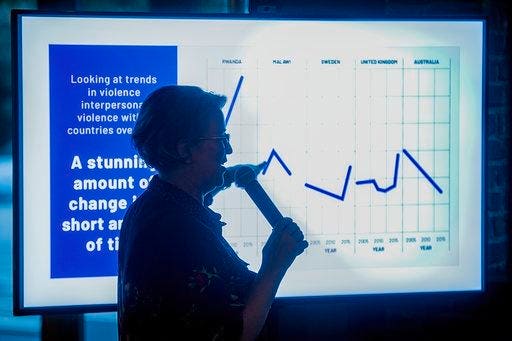Data often comes with the assumption that it represents an objective truth. However, once you peel back the layers, you quickly realize that data is subject to choices—choices that can influence results and have profound impacts.
Data lacking an equity lens can lead to misinformed policies, misallocated resources, and skewed interventions that might further exacerbate disparities in health and development outcomes. By adhering to these principles, policymakers and practitioners can ensure that interventions are targeted effectively, resources are allocated justly, and populations are treated with the fairness and dignity they deserve.
In this conversation with Heather Krause from We All Count, we’re exploring the need for an equity lens across data projects, barriers to data equity, and the impact of our choices.
Understanding Data Equity
While many sectors hold onto the myth that data projects can be value-neutral if executed correctly, this couldn’t be further from the truth. Whether it’s a tech giant trying to optimize an algorithm or a healthcare organization studying patient outcomes, the choices made during these projects inherently prioritize certain values or communities.
Simply put, data equity is a set of principles and practices to support anyone who works with data, especially related to people, do so with a lens of equity. Equity here is not merely an end goal, it’s the framework for all aspects of data from project design, to data collection, analysis, interpretation and communication.
Krause says data equity is ultimately about aligning quantitative data with the purpose and priorities of the work being undertaken. In her work, she acknowledges that while the the tools of statistics and data science don’t come with inherent biases, the perspectives of people shape decisions at every step and hence the outcomes.
The Reality of Choices
Every data project involves myriad decisions: from data collection methods to the kind of visuals on a dashboard. These decisions, regardless of how insignificant they might seem, have consequences.
For instance, an organization may rush to scale up an innovation, convinced of its profitability due to data findings. But without community representation in data collection, such an innovation could be unsustainable. Similarly, communities of color might find themselves at the shorter end of the stick when accessing start-up capital because of biased data models used to project success. Or advanced medical treatments might favor narrow genetic heritages, deepening health disparities.
One stark example of the impact of data projects designed without equity principles is malaria nets. In this examples, decision makers funding the distribution of malaria nets based simply on their efficacy in reducing infections, have failed to understand how they are being used on the group and factors impact when they are used for the intended purpose.
The impact of their choices and a singular read on data – the collapse of fisheries across Africa, stemming from the use of insectiside-treated malaria nets for fishing (New York Times).
However, when pressed for accountability, Heather often hears people entrusted with data projects say, “this framework assumes that we are empowered to actually make these choices… what if, like me, you aren’t?”
Her response is clear. You almost always have a choice.
She says, “However, do we really mean it when we say that we ‘don’t have a choice?’ Or do we mean ‘we don’t have a choice that costs us nothing’, or ‘we don’t have a choice that doesn’t make us uncomfortable’ or ‘we don’t have a choice that is easy/risk-free/requires no work on our part’.”
Incentives and Disincentives
According to Heather, most organization utilizing principles of data equity are internally motivated, adding, “organizations that are learning to build their competence in this are committed to retaining a healthy, productive workforce, and organizations who want their work to be accurate and useable.” For them, data equity isn’t just about fulfilling obligations. It’s about producing efficient, accurate, and usable data.
However, not all embrace this path, either due to oversight or a reluctance to shift from established patterns. The fallout of this reluctance often impacts the most vulnerable populations.
The failure to prioritize equity in data-driven decisions has dire real-world consequences, particularly for the most vulnerable populations. Consider the startup landscape: data models, built without an equity lens, have often misrepresented communities of color, portraying them as riskier investments. This flawed perception systematically denies these communities access to vital start-up capital, further entrenching economic disparities – today less than 1% of venture capital flows to Black founder (TechCrunch) .
In the healthcare sector, the pitfalls of not embracing data equity are equally glaring. Medical research, driven by skewed datasets, has sometimes expedited treatments tailored primarily for specific genetic heritages. The consequence? A healthcare system that inadvertently marginalizes broad swathes of the population, deepening health inequities. A striking exmple is the treatment of heart disease.
For years, medical research primarily studied men when developing treatments for cardiovascular diseases. As a result, many of the symptoms and treatment protocols became standardized based on male-centric data. It was later discovered that women often exhibit different heart attack symptoms than men. Because of this oversight, many women did not recognize their symptoms as indicative of a heart attack and thus did not seek timely treatment, leading to worse outcomes (Global Publich Health and Epidemiology).
In each of these scenarios, the repercussions of not making equity-focused choices in data projects are felt most acutely by those already experiencing marginalization.
Personal Responsibility in Data Projects
Whether you’re collecting, analyzing or communicating data, or are further upstream and funding or commissioning data projects – it is important to understand your own positionality and responsibilities. Heather says, “Recognizing and owning the choices made in every data project is a pivotal step toward ensuring that biases and inequalities are identified.”
The circular framework, developed by The University of British Columbia’s Sharon Stein, highlights patterns or traps that we fall into as we seek to embed equity in how we work. According to Heather, the principle of “continuity” as a foundational tenet of data equity.
This idea of an ongoing, cyclical understanding aligns profoundly with the concepts behind data equity. At its core, data equity emphasizes the conscientiousness of choice-making throughout the lifecycle of a data project. Just as the circular framework suggests an interconnected, continual approach to actions and consequences, so too does data equity urge for a sustained vigilance against the inadvertent introduction of biases and disparities. The confluence of these ideas recognize that, by actively recognizing and taking ownership of every decision within a data initiative, we can move closer to data-informed decisions that reduce harm.
A Final Note: Do We Really Not Have a Choice?
The Data Equity framework developed by We All Count shines a spotlight on the decisions to be made during a data project. Yet, individuals working with data argue that they lack the empowerment to make these choices. But is it truly a lack of choice, or is it an unwillingness to make decisions that might be uncomfortable, challenging, or entail some personal or professional cost?
Data equity’s primary challenge lies in ensuring that the burden of these decisions doesn’t fall onto society’s most vulnerable segments.
In our data-driven age, ensuring that data projects are fair, representative, and equitable isn’t just a nice-to-have—it’s imperative. By recognizing and embracing this, we can pave the way for a more inclusive and just digital future.
Heather Krause leads We All Count, a project to increase equity in data science. Interested in learning more about how you can embed these principles in your work? Explore We All Count’s framework, open-source tools, and learning opportunities.
Read the full article here










